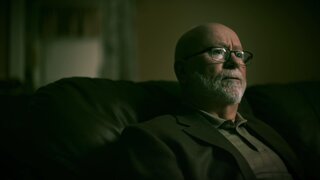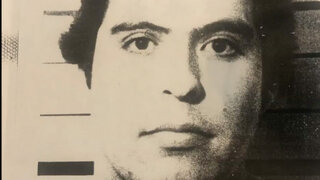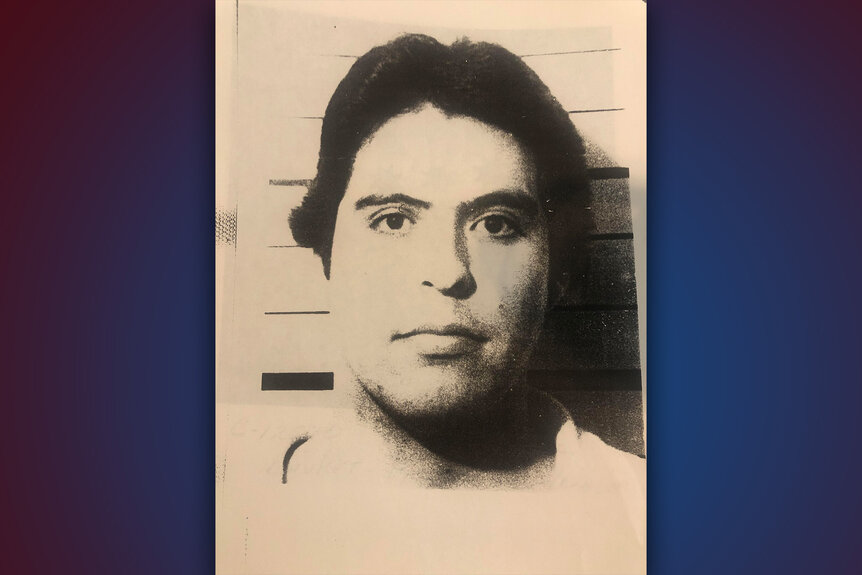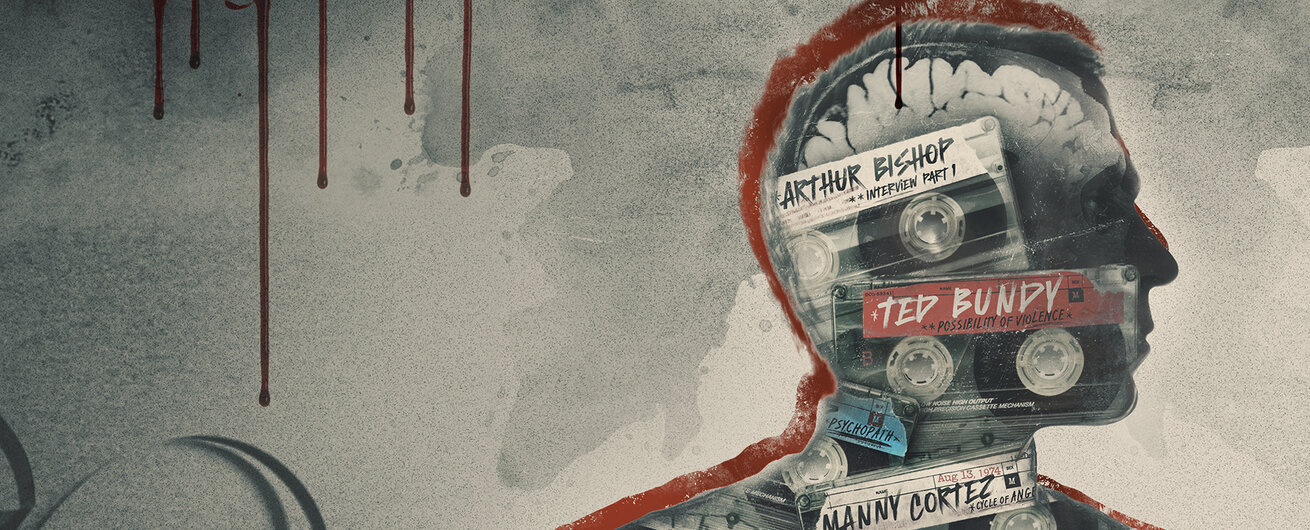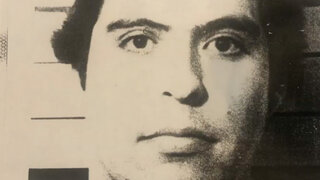Create a free profile to get unlimited access to exclusive videos, breaking news, sweepstakes, and more!
How a Book Inspired Child Killer Manny Cortez's Murder of Two Young Girls
Through his work with Dr. Al Carlisle, Manny Cortez was able to trace his violent roots to a book he found as a child that depicted violent acts against women.
For years Manny Cortez fantasized about a literary sadistic killer — until he became a killer himself, chillingly turning fiction into a terrifying reality.
Cortez pointed to the discovery of his uncle’s copy of The Torturer by Peter Saxon as a critical turning point in his young life, forever altering the path before him, as the book’s grisly torture of women worked its way into his sexual fantasies and, to him, served as a road map for his first violent rape, according to Oxygen’s Violent Minds: Killers on Tape.
“That changed my world,” Cortez said.
The California native later tried to understand his dark downward spiral and what led to a “need to terrorize” in sessions and phone calls that took place over 27 years with Dr. Al Carlisle, a psychologist who devoted his life to trying to understand the violent mind. Carlisle’s work and session recordings serve as the basis for the chilling series, which provides an eerie look into the mind of violent killers like Cortez.
Cortez was behind bars at Oregon State Penitentiary for the abduction and murder of two 11 year old friends, who disappeared on their way to the tennis court just two days after Christmas in 1979, but he’s considered a suspect in other disturbing crimes.
Cortez grew up in East Los Angeles as the youngest of seven siblings. His father, a counselor at a vocational rehabilitation center, instilled in his children that honesty was always the best policy, but when Cortez was about four years old he had a violent encounter with his father that would reshape his thinking.
“One night my father heard me going to the bathroom. And my father called out my name and asked if it was me, and I said, ‘yeah, yeah, it’s me,’” Cortez told Carlisle. “My father loved fruit, bananas and grapes, in particular. Well he got up that next morning and his banana was gone. And he asked me, ‘did you eat my banana?’ and I said ‘no’ and he didn’t believe me.”
Cortez said his father “slapped” and “whipped” him and forced him to stay in a corner until he confessed to the theft, even though he never took it.
Cortez realized that honesty might not be the best policy and decided that if someone was going to see you as bad even if you weren’t, there was no point of trying to be good.
“I was a scared, insecure kid who was trying to muster up some kind of sense of self-worth. It really rocked my world in terms of my trust for my father. I saw him as a monster then,” he said. “My father at that point became the boogie man as well as my enemy.”
His life took another shift when he was in fifth grade and discovered his uncle’s copy of The Torturer.
“It was a story about a guy who had a castle, and this guy was snatching up women of different nationalities and he would see which one of them would, you know, suffer best,” Cortez explained. “He would describe things that I had never known.”
The discovery came at an age where Cortez was naturally curious about male and female relationships — but it painted these interactions in a very dark and unnatural light.
“It described a woman on a table, her hands strapped down and her legs facing east to west,” Cortez said. “Once the victim was restrained, she was absolutely helpless at that point, he would start acting out the whole of his ritual.”
RELATED: Hypnosis Reveals Inmate's Suspected Alternate, And Deadly, Personality
Cortez became sexually aroused by the violent imagery.
“This was his sex guide. He had no feelings of violence at this time, this book became his guide,” Carlisle would later write. “Also he felt that aggressive sex was what women wanted.”
For years, Cortez fantasized about the book, identifying with the “unappealing” main character who saw himself as worthless and unappreciated.
“When you would fantasize and relive some of the things you had read in the book it was like you were becoming that person in the book,” Carlisle told him in one session.
Cortez agreed the book acted as “foreplay” and had a hold on him for years.
“I don’t think that my mind will ever be entirely free of that connection. It was an escape. I was in there. I could almost smell the smells and I was gone,” he said. “I was in another world.”
Cortez was 17 years old when he had his first romantic relationship with a 15-year-old girl named Cindy.
“I was very serious. She was very outgoing. I didn’t have a lot of friends and she had about a hundred, you know. She loved to party, go to parties and be around a lot of folks. I didn’t,” he remembered. “When I realized that she really took a liking to me, it fed my ego.”
He tried to maintain the romantic relationship, but over time he admitted he often would “leave her in tears” because of his “aggressive” physical expectations of the relationship.
As the relationship started to come to an end, he set out “trolling” for his “ideal victim” and found her in 1976.
Cortez confessed to Carlisle that he lured a 15-year-old girl from his neighborhood to his home after running into her at a store.
When they got to the vacant house, he took out a knife and tied her up, then raped and abused her for hours, meticulously carrying out many of the violent acts from the book.
“That was I mean almost blow by blow by blow by blow exactly like that book. I am that tall, skinny, sunken face, skull face guy, you know, the way he was described in the book. That’s who I imagined myself,” he said. “I was in control. In the book, he had a ring, and like, for example, he placed his hand on this gal’s body. And that’s what I did.”
After carrying out the violent assault, Carlisle said he realized the “fantasy’s done” and he had a real person in front of him.
“What do you do with the person after you’re done? She’s not human to me. She’s not a person to me. She’s just a problem,” he said.
Cortez told the girl that he had been seeing a psychiatrist and begged her forgiveness and let her leave, but her family quickly realized something wasn’t right and convinced her to report the attack. However, charges were not filed.
Cortez called getting away with the violent attack his “final turning point” and made him determined to “never leave a living witness again.”
Just three years later, Cortez — who fancied himself as the next Ted Bundy — abducted 11-year-old best friends Rachel Isser and Deanna Jackman.
The girls were on their holiday break from school on December 27, 1979 when they decided to go play tennis not far from their Ashland, Oregon homes. Det. Les Rainey of the Eugene Police Department told Violent Minds: Killers on Tape that one of their girl’s mothers began to worry that they weren’t dressed warm enough and went to bring the girls coats, but wasn’t able to find them and called Ashland Police.
Police were able to determine the most likely route the girls would have taken to the court, which led them straight through the campus of Southern Oregon College, where Cortez later admitted he had been out “trolling.”
“There was a need to terrorize,” Cortez told Carlisle during their discussions. “The need for violence.”
RELATED: Understanding The History of Criminal Profiling
Jackman’s distraught father — who was also searching the area — stumbled upon Isser’s naked body in a press box by the campus stadium.
"She had been strangled by ligature that was still attached around her neck,” Rainey said, adding the 11-year-old had also suffered cuts, burn marks from a cigarette and had been sexually assaulted.
Yet there was no sign of Jackman.
Cortez would later describe taking Jackman to a house nearby where he had been housesitting. Cortez and Jackman — who still believed her friend was alive and they’d go back for her if she cooperated — chillingly passed by a police car on their walk, but the 11-year-old was too worried for her friend’s safety to run for help.
“She didn’t go to the police car. And I think that in all probability that she was thinking more of her friend than of herself,” Cortez said, describing almost being caught as an ”altered state of mind.”
He took her to the home where he killed her and then dumped her body at a quarry several miles out of town. Police were able to link the violent crime to Cortez after a bloody quilt he used during the crime was discovered stuffed into a trash can at a car wash and the owner of the home where he had been housesitting recognized it as a family heirloom.
By then, Cortez had already gone on the run, but police were eventually able to track him down at his family’s home in Valinda.
Cortez was convicted and sentenced to two consecutive terms of 25 years to life — but he admitted to Carlisle that if he hadn’t been arrested, his crime spree likely would have continued.
“Oh, I’m sure I would have kept right on killing,” he said.

